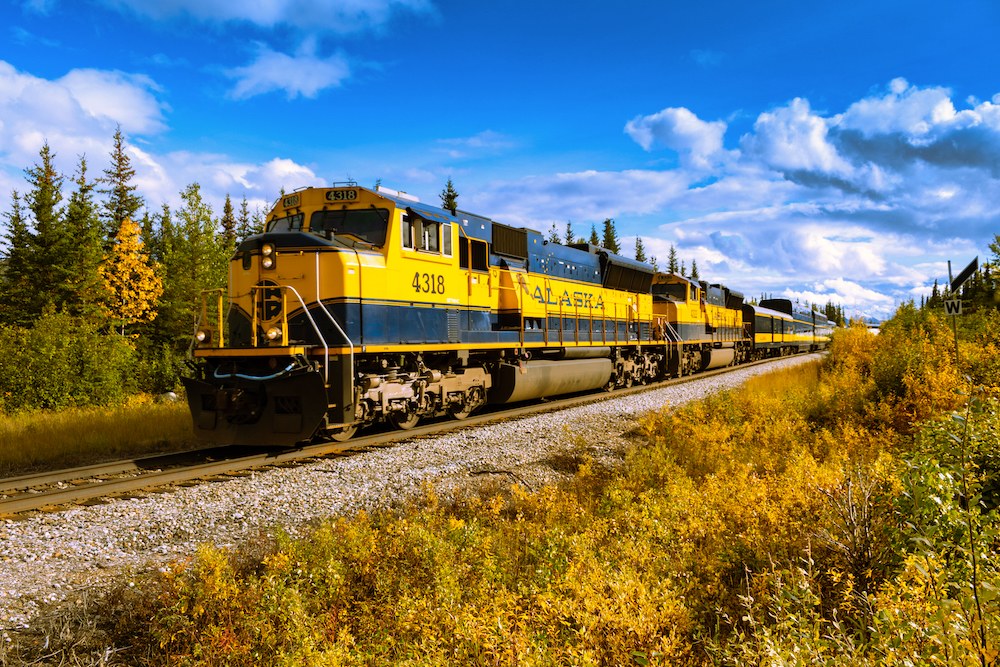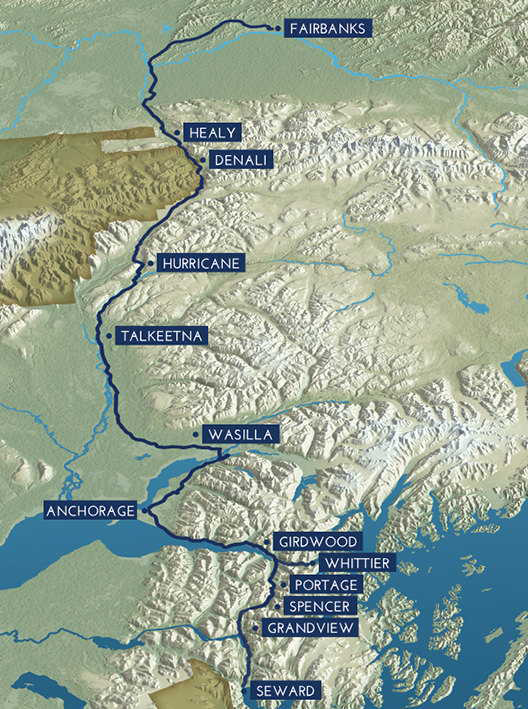
JUNEAU, Alaska — A state legislator has introduced a bill calling for privatization of the Alaska Railroad — although even the bill’s sponsor says the purpose is as much about inspiring discussion as it is about potentially triggering a sale.
HB 332, introduced by Rep. Jesse Sumner (R-Wasilla), calls for the state’s governor to request proposals for purchase of the railroad and related assets by June 15 of this year, and sell the railroad by Feb. 15, 2025, to the party that makes the best offer to continue to operate the railroad for a minimum of 50 years while assuming all existing contracts, including those with labor, shippers, and connecting carriers. The agreement would be subject to approval by the legislature.
Sumner’s Sponsor Statement for the bill says the railroad, under state ownership, “has faced limitations in terms of investment, innovation, and strategic expansion” and that the sale would “streamline governance and inject much-needed private sector expertise into the railroad’s operations.” It also includes a resource development agreement that the statement says “positions the Alaska Railroad to be a key catalyst for unlocking responsible, sustainable expansion of our state’s vast resources.”

“I think at least a conversation about the direction of the railroad is headed and resource development is in order,” Sumner told a March 21 meeting of the state House Transportation Committee. “Whether or not ultimately we should sell the railroad, certainly, is up for debate.”
The railroad, completed by the federal government in 1923, was transferred to state ownership in 1985 under a bill signed by President Ronald Reagan in 1983. Since that date, Transportation Committee Chair Kevin McCabe (R-Big Lake) said, “The railroad has not built one single mile of track. Our resource development since that time has been stifled beyond belief. … They haven’t kept up with our needs. Whether it’s their fault or our [the legislature’s] fault, or both … we’ve got to do something.
“There are people out there that would be interested in building track and helping the state of Alaska develop its resources. Is this a motivational bill? Probably. But it’s also a venue if we need it.”
McCabe also expressed concern that Port MacKenzie, a deepwater port across a body of water known as Knik Arm from Anchorage, does not have rail access. A 32-mile spur to reach the port remains in the planning stage.
“It’s imperative that we get rail to Port MacKenzie, and if has to be through a private corporation rather than a state corporation, that’s what we have to do,” McCabe said.
He also suggested that the stalled A2A project — seeking to link Alaska and Alberta, providing a through connection to the rest of the North American rail network — remains a consideration [see “Company seeking to build Alaska-Alberta rail line enters bankruptcy,” Trains News Wire, June 28, 2021].
“Yes, the private guy they had in there had some issues, and it fell apart, and it seems like pie in the sky,” McCabe said. “But there are many, many, many reasons to put that rail through Canada to the lower 48. It might be as small a reason as hauling that clean Alaska coal to a power plant in North Dakota … or hauling potash from Saskatchewan back to Port MacKenzie or the Port of Anchorage for shipment to Asia.”
The Transportation Committee took no further action after its initial discussion.














Another extremist Legislator’s solution in search of a problem. Clearly, it’s been a long, dark winter and he’s run out of entertainment. 😰
Just say no.
It’ll all be about how much profit can we get while we degrade safety, service, & maintenance.
Just look to the lower 48.
The Alaska R.R. looks like a good candidate for a modern, mainline heavy electrification.
I suggest they contact Drexel Infrastructure Partners. They seem willing to fund these type of projects… See the Uintah Basin Railway as an example.
The White Pass seems to have done OK after they went private. And if not for covid, they would be working on their excursion extension into the Yukon right now.
The Canadian Government just threw over $200 million CDN into upgrading the line to Churchill, which has even less local customers than the A2A.
So for private equity to get involved, there would have to be several revenue sources to cover their costs.
As for minerals, all the money both private and public is going towards mining the back side of the moon. That is how bad permitting has become. That leaves tourism, real estate, common aggregates, lumber and military use cases.
After a base metals mine in the Yukon closed the WP&Y almost went out of business. Its only traffic now is tourists, almost all off the cruise ships. The track from Carcross to Whitehorse is still in place but I don’t think it will be rebuilt because the tourist business is basically a one day ride to Carcross or White Pass, bus one way, train the other. Going on to Whitehorse doesn’t add much scenery but it would add probably at least two hours to the day trip. I don’t think the tourists or the cruise lines would be interested. The only possibility would be new mining business but with the current Whitehorse-Skagway road I’m not sure the WP&Y could compete..
Private capital partners will want a cut if the action, so much money per ton or the like. There would be as much to gain in rail profits as there was in the Trans Alaskan Pipeline. There could be some government grants from the Canadian and US Feds as well as provincial governments (Yukon, NW Territories, Alberta, maybe British Columbia.) and the State of Alaska since it will be a huge benefit to them to not have to depend on barge traffic. Perhaps even Canadian National might chip in a little. I doubt CP would do anything because it would cost them and they would not control it. But who knows…maybe a change of practice on their part might be in the offing.
Looking at the big(ger) picture, I not only see an economic boom for AK and Alberta, CA, but a domino trickle down effect to the North American economy. Not only that, A2A would be a major link towards a possible Asian RR connection via the proposed Interbering RR tunnel that could/would link North America with Russia, China, Korea, etc. I’m a believer that nations that engage in free international trade are less inclined to make war with each other.
As a 35+ year resident of Alaska, this is a pretty silly idea. The State Legislature currently can’t seem to be able to fund basic school funding, road maintenance or adequate funding for the much used state ferry system. A proposal to sell the State-owned railroad to any private investment group is a pretty high bar to reach. ARRC is precluded from expanding due to the lack of state funding. There were attempts to lengthen the railroad to Delta Junction as part of the planning and building of the proposed natural gas line to Canada. In fact, with Federal funds, the Tanana River Bridge has already been built, the route has been surveyed, the permitting process for construction was initiated. However, the Legislature never funded the construction, “it was too costly”. The Point McKenzie Access Rail line has been graded, the lack of construction funds from the State Legislature stopped construction, “it was too costly”. Unfortunately, a number of Legislators speak a good line, unfortunately they are pretty poor on delivery.
My favorite money phrase: “Talk is cheap but it takes money to buy Whiskey.” Politicians never have any money because they spend so much of their time putting it in their own pockets!
Many years ago BC Rail started building to Alaska from Prince George. If you drive the Cassiar Highway you can see some graded roadbed south of Dease Lake on the way to the Skeena River crossing. But half of the completed line was out of service after a few years because there was no traffic; the only traffic available was from some (marginal) lumber mills. So a road to Alaska would be looking at crossing over a thousand miles with no local traffic at all. If you drive the Alaska Highway you won’t see many trucks. The most likely source of freight might be from new mines but nobody wants to permit them.
Well, the good news is that someone has surveyed the proposed 1,600 mile route, which is not obvious compared to at least one of the alternatives. (Three alternatives would be linking to the former BC Rail in BC, or the two former NAR routes in Alberta).
How much oil is now shipped on the exiting former NAR route to Edmonton? That might be an indication of possible oil traffic on the new railroad west to Alaska.
Anyone who wants to build a 1,600 mile railroad through the mountains and across the sub-arctic muskeg, through an area of near-zero population, is welcome to try providing it’s with their own money.
Its not just about oil, Charles. Its about all the other products that could be exported more cheaply and for North American benefit were they to go by rail rather than the round about ocean going or intercostal waterway route between Alaska and Vancouver/Seattle. Also, it would be much cheaper for Alaskans to get the things they need by rail than the “long way around.”
There are many minerals and ores in Alaska that could be mined carefully and responsibly which are not currently engaged due to the high cost of extracting them which is mostly tied up in transportation costs. That would be the big advantage of the A2A route because it would be fairly direct to the consuming industries that could re-manufacture or refine them by the tie-in to the North American Rail System.
Yes let Ancora developed the RR
YES!!! Especially A2A!